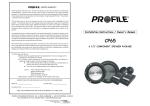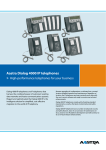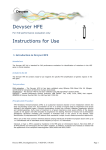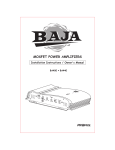Download MDS MDS GP2 Owner`s manual
Transcript
MOSFET POWER AMPLIFIERS Installation Instructions / Owner's Manual MDS GP2 MDS GP3 MDS GP4 MDS - Multi Dynamic Systems of Sweden AB Midsommarv. 8-10 126 35 Hägersten +46(08)556 00 740 www.mds.se 1 INTRODUCTION Congratulations on your purchase of a MDS state-of-the-art power amplifier. Your selection of a MDS product indicates a true appreciation of fine musical reproduction. Whether adding to an existing system or including your MDS amplifier in a new system, you are certain to notice immediate performance benefits. KEEP YOUR SALES RECEIPT Take this time to attach your sales receipt to the manual and put in a safe place. In case of any unforeseen reason this product may need warranty service, your receipt will be necessary to establish purchase date. RECOMMENDATION A power amplifier’s performance is only as good as its installation. Proper installation will maximize the system’s overall performance. It is recommended that you have our product installed by an authorized MDS retailer. However, if you decide to install it yourself, please carefully read through this manual and take your time to do a quality installation. IMPORTANT! Before making any connections, disconnect the car’s battery until the installation is completed to avoid possible damage to the electrical system. WARNING! Exposure to high power sound system can cause hearing loss or damage. Listening to your system at loud levels while driving, will impair your ability to hear traffic sounds and emergency vehicles. Use common sense when listening to your system. Serial # Model # 2 SAFETY PRECAUTIONS Fuse amplifiers power wire at the battery. Be sure to fuse the power wire within 12” of the car's battery. This will protect the car's battery in case of a short circuit between the power amplifier and battery. THIS IS A MUST, the amplifier's built-in fuse will only protect the power amplifier not the car's battery! Use high grade wire connectors. To ensure maximum power transfer and secure safe connections, it is recommended to use high grade barrier spades (for connection at amplifier) and terminal rings (for connection at battery). Do not run any wires underneath vehicle. Exposed wires have a chance of being cut or damaged. It is best to run all wires through the vehicle under the carpet and/or side panels. This lends to a cleaner installation and less risk of damage. Use caution when mounting amplifier. Remember there are many electrical wires, gas lines, vacuum lines, brake lines as well as a gas tank in the automobile. Make sure you know where they are when mounting the amplifier to avoid puncturing lines, shorting wires or drilling holes in the gas tank. Run signal wires away from electrical wires. To avoid possibility of induced noise from the car's electrical system (i.e. popping noises or engine noise), run wires away from the car's electrical wiring. Make all ground wires as short as possible and at the same point. In order to reduce the chance of ground loops (i.e. engine noise), make the grounding wire as short as possible to reduce the wire's resistance. Also, when using multiple components, make sure all units are grounded at the same point. Avoid sharp edges when running the wires. To avoid the possibility of power, signal or speaker shorts, be careful not to allow the amplifiers wires to come in contact with sharp edges. Use a grommet to protect the wire when running through the fire wall . 3 FEATURES AND BENEFITS DC Offset Protection This circuit protects the output of the amplifier against DC voltage. If for some reason DC voltage is detected at the output stage, the amplifier will shut down protecting the speakers from direct current. Short Circuit Protection The circuit protects the amplifier from damage due to a short found in the speakers or wiring. If one of the speakers or its wiring comes in contact with ground, the amplifier will shut down. To resume normal operation, correct the problem and turn the head unit off, then back on. The amplifier will reset and play again. Thermal Protection To protect the amplifier circuitry against damage caused by prolonged exposure to high temperatures, a thermal protection circuit is activated if the amplifier reaches excessively high operating temperature. Once the thermal circuit is activated, the amplifier will shut down to cool off. The amplifier will automatically turn back on once it cools down to a safe operating temperature. Power & Protection Indicator The power L.E.D. Illuminates when the amplifier is on and receiving power. The protect LED Illuminates when the amplifier has gone into the protection mode (Please refer to our trouble shooting section). Tri Mode Capable If so desired, the amplifier may be run in stereo and mono at the same time. For example, this feature would allow you to run a pair of mid and tweeters in stereo and a sub-woofer mono. Built-in Crossover The MDS amplifiers include a built-in variable **high and low pass crossovers. The crossover features a variable frequency selection (40Hz ~ 400Hz) for precise high or low pass filtering. Bass Boost For added low frequency performance the amplifiers are equipped with a variable 0~12 dB bass boost @ 45Hz. Line Output One set of full range line outputs have been provided for convenient connection to additional amplifiers in the system. 4 Power Fusing This protects the amplifier against short circuits and excessive current. Remote Turn-on Automatically turns amplifier on when connected to the head unit's remote output. The amplifier will turn on and off with the head unit to save current consumption. This control also operates the reset circuit for the amplifier's protection. It must be connected with the head unit in order to reset protection circuits. Adjustable Input Sensitivity Allows you to fine-tune the level matching between your source and the power amplifier. High Level Input Allowing for integration with “Factory Sound Systems”. Stable To 2 Ohm Stereo Mode Stability to 2 ohm in stereo mode, 4 ohms bridged. 5 MOUNTING LOCATION Before you start the installation, it will be necessary to find a mounting location for the amplifier. Find a location in which the amplifier will receive adequate ventilation in order to dissipate the heat it develops during operation. Two popular mounting locations are in the trunk or under the seat. Select the location in which you wish to mount the amplifier. Use caution when mounting amplifier, there are many wires, gas lines, vacuum lines, brake lines as well as a gas tank in the automobile. Make sure you know where they are when mounting the amplifier to avoid puncturing lines, shorting wires or drilling holes in the gas tank. Once you are ready, use a pencil to mark the mounting holes in the bottom panel. After you have marked the locations of the holes move amplifier out of the way and drill small starter holes to make the tapping screws easier to install. Use provided screws to tighten down the amplifier. INPUT REMOTE HI-INPUT FRONT REAR GAIN +L- HI-INPUT OUTPUT +R- +L- X-OVER +R- X-OVER MAX MIN FILTER BASS BOOST POWER PROTECT GAIN L BASS BOOST MAX MIN FILTER R 40Hz OdB 12dB 400Hz HPF FULL LPF HPF FULL LPF 6 40Hz 400Hz OdB 12dB POWER CONNECTIONS FUSE L+ POWER SPEAKERS R+ +12V REM GND 20A BRIDGE IN-LINE POWER FUSE MOUNTED WITHIN 12" FROM BATTERY RECOMMENDED (NOT PROVIDED) RADIO'S REMOTE TURN-ON OUTPUT + - CAR BATTERY +12V 94.7 IMPORTANT! Before making any connections, disconnect the car’s battery until the installation is completed to avoid possible damage to the electrical system. Connect the amplifier to the car's battery. At times, the amplifier will need to draw large levels of current that cannot be provided by any circuit in the car's fuse box. We recommend using a 4 to 8 gauge power wire for your connections depending on the amplifier and length of the wire. Strip one end of the wire and crimp on a barrier spade connect to the terminal on the amplifier marked “+12V”. Loosen screw terminal and connect barrier spade and tighten. Use caution to make sure no stray wire stands come in contact with surrounding terminals causing short circuits. Run the wire directly to the positive terminal of the car's battery. Make sure to use an inline fuse within 12” of the car's battery to protect the electrical system and amplifier against short circuits and/or power surges. Connect the ground terminal of the amplifier to the car's chassis. For the ground connection, use an 4 to 8 gauge wire (black) to connect to the terminal marked GND and then connect it to the car's chassis. Try to keep the length of the cable as short as possible, preferably less than 6". Also make sure that the point on the car where the connection is to be made is free of paint and dirt. Connect the remote terminal of the amplifier to a switchable +12V source. This connection allows the amplifier to be turned on and off with the power control of the radio. If the radio has a REMOTE output terminal, connect it to the amplifier's terminal marked REMOTE (using a 16 gauge wire or heavier). Now when the radio is turned on, the amplifier will automatically turn on. This connection can also be made to the radio’s Power Antenna wire. 7 SIGNAL CONNECTIONS Connect the RCA output of the head unit (AM/FM cassette player, CD, or DAT) to the RCA input terminals of the amplifier. To make these connections, we recommend high quality RCA cables, which are available at your local car audio retailer. Run signal wires away from electrical wires to avoid possibility of induced noise from the car's electrical system (i.e. popping noises or engine noise). Please note that when making these connections the signal inputs correspond with the speaker outputs. INPUT BASS BOOST FILTER X-OVER OUTPUT L L +L- R R HPF FULL LPF REMOTE 12dB OdB 40Hz HI-INPUT GAIN +R- POWER MIN 400Hz MAX L PROTECT R TWO CHANNEL SIGNAL CONNECTIONS INPUT REMOTE HI-INPUT FRONT REAR HI-INPUT OUTPUT GAIN +L- POWER PROTECT GAIN L +R- +L- L X-OVER MAX MIN FILTER BASS BOOST OdB L 12dB 400Hz BASS BOOST MAX MIN FILTER R 40Hz +R- X-OVER R HPF FULL LPF HPF FULL LPF R R FRONT REAR FOUR CHANNEL SIGNAL CONNECTIONS 8 L 40Hz 400Hz OdB 12dB Optional full range line out connection to additional amplifiers in the system. HIGH LEVEL CONNECTIONS (OPTIONAL) High Level inputs have been included to connect the amplifier to a radio without low-level outputs (i.e. factory radio). This connection will allow you to connect directly to the speaker output of the radio with out the need of an external adapter. Determine the type of radio you have and make one of the following connections. CAUTION! Before making any connections determine the type of radio to avoid possible damage to amplifier and/or radio. INPUT OUTPUT L L REMOTE BASS BOOST X-OVER POWER GAIN FILTER R OdB 12dB 40Hz 400Hz R PROTECT MAX MIN HPF FULL LPF HI-INPUT +L- +R- 94.7 LEFT LEFT + - WHITE WHITE/BLACK BLACK (GROUND) (NOT USED) RIGHT RIGHT + - GRAY GRAY/BLACK TWO CHANNEL CONNECTIONS: FLOATING GROUND RADIO (MOST COMMON TYPE) INPUT REMOTE BASS BOOST X-OVER OUTPUT L L R R POWER GAIN FILTER OdB 12dB 40Hz 400Hz HPF FULL LPF MIN HI-INPUT +L- 94.7 LEFT + WHITE WHITE/BLACK (NOT USED) BLACK GROUND RIGHT + GRAY GRAY/BLACK (NOT USED) TWO CHANNEL CONNECTIONS: COMMON GROUND RADIO 9 PROTECT MAX +R- INPUT HI-INPUT REMOTE FRONT REAR HI-INPUT OUTPUT GAIN +L- POWER PROTECT GAIN L +R- +L- X-OVER MAX MIN FILTER BASS BOOST +R- X-OVER BASS BOOST MAX MIN FILTER R 40Hz OdB 400Hz 12dB HPF FULL LPF HPF FULL LPF 40Hz 400Hz OdB 12dB 94.7 + GRAY/BLACK RIGHT GRAY RIGHT BLACK (GROUND) (NOT USED) WHITE/BLACK LEFT WHITE LEFT LEFT LEFT + - GREEN GREEN/BLACK BLACK (GROUND) (NOT USED) + RIGHT RIGHT + - PURPLE PURPLE/BLACK FOUR CHANNEL CONNECTIONS: FLOATING GROUND RADIO (MOST COMMON TYPE) INPUT REMOTE HI-INPUT FRONT REAR HI-INPUT OUTPUT GAIN +L- POWER PROTECT GAIN L +R- +L- X-OVER MAX MIN FILTER BASS BOOST +R- X-OVER BASS BOOST MAX MIN FILTER R 40Hz OdB 400Hz 12dB HPF FULL LPF HPF FULL LPF 40Hz 400Hz OdB 94.7 GRAY/BLACK (NOT USED) GRAY RIGHT + LEFT BLACK GROUND LEFT GREEN BLACK GROUND RIGHT WHITE/BLACK (NOT USED) WHITE + GREEN/BLACK (NOT USED) + + PURPLE PURPLE/BLACK (NOT USED) FOUR CHANNEL CONNECTIONS: COMMON GROUND RADIO 10 12dB SPEAKER CONNECTIONS Make the speaker connections using speaker wire that is at least 16 gauge or heavier. As with any audio component, proper phasing of the amplifier and speakers is essential for strong bass response. When connecting, make sure that positive (+) from the amplifier is connected to the positive (+) of the speaker, and the same for negative (-). FUSE L+ POWER SPEAKERS R+ +12V - 4 Ohm Speakers (2 Ohm Minimum) GND 20A BRIDGE + REM + - TWO CHANNEL SPEAKER CONNECTIONS BRIDGE + LF + RF - FUSE +12V + LR + RR BRIDGE 30A 4 Ohm Speakers (2 Ohm Minimum) POWER REM GND 30A 4 Ohm Speakers (2 Ohm Minimum) FOUR CHANNEL SPEAKER CONNECTIONS 11 SPEAKER CONNECTIONS (BRIDGED) The MDS amplifiers are capable of being bridged in a mono configuration. This feature allows you the flexibility of using the amplifier to drive a ** subwoofer or a center channel. In this configuration the amplifier sums the right and left channel to deliver one channel (mono) output. Please note: in order for the amplifier to sum right and left signal information, both right and left RCA connections must be made. **CAUTION! In the bridged mode, the amplifier must see a 4 Ohm load or higher. Any lower than 4 Ohms will cause the amplifier to overheat and possibly cause permanent damage to the amplifier! FUSE L+ POWER SPEAKERS R+ +12V GND 20A BRIDGE 4 Ohm Speaker REM + TWO CHANNEL BRIDGED SPEAKER CONNECTIONS BRIDGE + LF + RF - FUSE +12V + LR + RR BRIDGE 4 Ohm Speaker 30A 30A 4 Ohm Speaker FOUR CHANNEL BRIDGED SPEAKER CONNECTIONS 12 POWER REM GND SPEAKER CONNECTIONS (TRI-MODE) The amplifier is capable of running in a Mono / Stereo mode. This feature gives the amplifier the ability to run stereo satellites (midbass & tweeter) simultaneously with a mono subwoofer. These connections are more complicated because they require the use of passive crossover networks (Not provided) to divide the frequencies to the speakers. We have included a sample diagram for 4 Ohm connections. If you wish to use multiple speakers to achieve a lower impedance and higher power, it is strongly recommended that you seek professional advice from your MDS retailer before attempting to make these connections. Please Note: In the Tri-mode configuration, the amplifier’s built-in crossover must be set to the ”FULL” position so the speakers receive full range output. FUSE L+ POWER SPEAKERS R+ +12V REM GND N D 20A BRIDGE - 100 F + - 4 mH Left Mid / Tweeter 4 Ohm (2 Ohm Minimum) 100 F + - Right Mid / Tweeter 4 Ohm (2 Ohm Minimum) L Mono Woofer 8 Ohm (4 Ohm Minimum) E G NON-POLAR CAPACITOR CAUTION! E INDUCTOR (COIL) In Tri- mode operation, the amplifier must see a 2 Ohm load or higher for the stereo satellites and no lower than 4 Ohms for the subwoofer(s). Any lower than the above mentioned impedance will cause the amplifier to overheat and possibly cause permanent damage to the amplifier. 13 REMOTE BASS CONTROL MODULE (OPTIONAL) Before connecting the remote, it will be necessary to find a mounting location that will be easy to access for adjustment. Once you select your mounting location, you will need to run the control wire from the remote to the amplifier. To avoid possibility of induced noise from the car's electrical system (i.e. popping noises or engine noise), run the cable from the remote to the amplifier away from the car's electrical wiring. Please note: Once the remote is plugged in, it overrides the bass boost on the amplifier and becomes the primary bass adjustment. INPUT BASS BOOST X-OVER FILTER REMOTE OdB 12dB 40Hz 400Hz OUTPUT HI-INPUT GAIN L L +L- R R HPF FULL LPF +R- POWER MIN 14 MAX PROTECT ADJUSTING THE X-OVER AND BASS . (Please note: If you intend to use the amplifier in the Tri-mode configuration, it is necessary to set the crossover control to the “FULL” setting in order to receive full range output) The amplifiers are equipped with a built-in variable crossover network allowing you to select the crossover type (i.e. Low-Pass or Hi-Pass) and the desired crossover point. For example if you wish to drive a pair of subwoofers, you can select the “Low Pass” setting on the amplifier to filter out high frequencies. This will send only low frequencies to your subwoofers (see example settings below). The crossover point should be determined by the speakers operating range. Please refer to speaker manufactures recommended crossover point. Select the crossover type on the amplifiers side panel. (Low-pass is selected in this example for subwoofers) FILTER You can add up to 12dB bass boost by increasing the Bass Boost control. X-OVER BASS BOOST HPF FULL LPF 40Hz 400Hz OdB 12dB Select the crossover point for your speakers. FINE TUNE THE SYSTEM Fine tune the amplifier's input sensitivity. GAIN The gain sensitivity control for the MDS amplifier is located on the side panel. This gain control has been included to allow adjustment to properly match the output of the radio. This is one of the most misunderstood adjustments. By rotating the control in MAX MIN the clockwise direction, the amplifier‘s input will become more sensitive and the music will play louder. This is not a volume control and you will not get more power out of the amplifier in the maximum position! It may seem to deliver more output, but actually the system is only playing louder faster as you turn the volume control on the radio. Ideally, to properly level match the system the goal is to achieve maximum output from the amplifier without distortion at about 3/4 of the volume control. To determine if the amplifier’s gain is set properly, turn the system on and slowly increase the volume control. You should be able to use about 3/4 volume before the system gets loud but not distorting. It is very important when making these adjustments that you do not over drive the speakers (at point of distortion) this will cause permanent damage to the speakers. If you are unable to achieve 3/4 volume before distortion you will need to adjust gain control (in this case you would reduce the gain). The gain controls should be adjusted very slowly. It may help to have another person to assist you by adjusting the gain controls while you listen for distortion. 15 TROUBLE SHOOTING THE SYSTEM We have put together this trouble-shooting guide if you experience problems after installing the amplifier. Please keep in mind that the majority of problems incurred are caused by improper installation and not the equipment itself. In addition, there are many components in the system that could cause various signal problems such as inducted electrical noise and engine noise. Before you can properly address the problem, you must first find the component that is causing the problem. This will take patience and a process of elimination. LOOK FOR.... SOLUTION No Output Blown fuse Bad RCA Cable(s) +12V at power terminal +12V at remote terminal Grounding point clean and tight Head Unit's fader not in center position Replace Replace Check connection Check connection Check for ground w/meter Set to center position Low Output Check level adjustments Bad RCA cable(s) Improper level matching Re-adjust Replace Re-adjust Engine Noise Grounding points are clean and tight Ground all components at same point Try different grounding point Bad RCA cable(s) Use High Quality shielded RCA cables Low Vehicle charging system and/or battery Check for ground w/meter Ground at same point Change for better ground Replace Rejects inducted noise Fix and/or replace Protection L.E.D. Illuminated Speaker short Check speakers connection for short circuit Make sure speaker wires do not touch chassis ground Check speaker impedance (Min 2 ohm Stereo, 4 Mono) Check mounting location for Adequate air Circulation Speaker impedance too low Speaker grounding out Impedance too low Overheating 16 SPECIFICATIONS Output Power @ 14.4 VDC : Max Output 4 ohm 2 ohm Bridged 4ohm Frequency Response S/N Ratio (A-weight) THD with 20k filter Channel Separation Low Input Level Hi Input Level Battery Voltage Range Crossover Type Crossover Frequency Crossover Slope Bass EQ at FULL/LP Fuse MDS GP2 MDS GP3 MDS GP4 100W x 2 max 50W x 2 75W x 2 150W x 1 10Hz-25KHz >75dB .30% 45dB 200mV-5V 1.5V-14V 10.5VDC-16VDC HPF/FULL/LPF 40Hz-400Hz 12dB/Oct 0-12dB @ 45Hz 1 x 20A 240W x 2 max 120W x 2 180W x 2 380W x 1 10Hz-25KHz >75dB .30% 45dB 200mV-5V 1.5V-14V 10.5VDC-16VDC HPF/FULL/LPF 40Hz-400Hz 12dB/Oct 0-12dB @ 45Hz 2 x 25A 140W x 4 max 70W x 4 105W x 4 210W x 2 10Hz-25KHz >75dB .30% 45dB 200mV-5V 1.5V-14V 10.5VDC-16VDC HPF/FULL/LPF 40Hz-400Hz 12dB/Oct 0-12dB @ 45Hz 2 x 30A Due to continuing product improvement, specifications subject to change without notice. 17 18 Manual By MDS - Multi Dynamic Systems of Sweden AB Midsommarv. 8-10 126 35 Hägersten +46(08)556 00 740 www.mds.se www.extremeconcepts.com MDS AMP REV 1.31.04
































